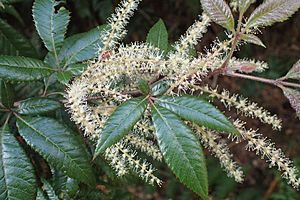Southern marara facts for kids
Quick facts for kids Southern marara |
|
|---|---|
 |
|
| Foliage and male flowers | |
| Scientific classification | |
| Genus: |
Vesselowskya
|
| Species: |
rubifolia
|
| Synonyms | |
|
|

The Vesselowskya rubifolia, often called southern marara, red ash, mountain marara or Dorrigo southern marara, is a type of flowering plant. It belongs to the Cunoniaceae plant family. This plant is only found in a small area of eastern New South Wales, Australia. It can be a shrub or a small tree. It has special leaves made up of smaller parts, and tiny whitish flowers that grow in a line.
Contents
What Does Southern Marara Look Like?
The Southern marara is a shrub or a tree. It usually grows to be about 6–8 m (20–26 ft) tall. Its trunk can be up to 25 cm (9.8 in) wide. The bark is thin and a light brown color.
When the plant is young, its new shoots, parts of its leaves, and flowers are covered with long, flat hairs. Its leaves grow in pairs opposite each other on the stem. Each leaf is made up of three or five smaller leaf parts called leaflets. These leaflets have sharp, saw-like edges. All the leaflets connect to one spot at the end of a stalk called a petiole.
The leaflet at the very end is usually 40–120 mm (1.6–4.7 in) long and 20–40 mm (0.79–1.57 in) wide. It has its own small stalk, or petiolule, about 8–11 mm (0.31–0.43 in) long. The leaflets on the sides are 30–70 mm (1.2–2.8 in) long and 15–25 mm (0.59–0.98 in) wide. Their small stalks are 2–4 mm (0.079–0.157 in) long. If there are two leaflets at the very bottom, they are smaller, about 5–20 mm (0.20–0.79 in) long and 5–17 mm (0.20–0.67 in) wide. They either have no stalk (called sessile) or a very short one, up to 2 mm (0.079 in) long.
Flowers and Fruit
Southern marara has separate male and female flowers. They grow in long clusters called racemes. These clusters are about 40–80 mm (1.6–3.1 in) long and grow where the leaves meet the stem. When the female flowers turn into fruit, their clusters can grow even longer, up to 150 mm (5.9 in).
Each flower has three whitish sepals, which are like small leaves that protect the bud. It also has three whitish petals, which are about 1.5 mm (0.059 in) long. The plant flowers in spring. After flowering, it produces an oval-shaped, pale brown fruit. This fruit is a capsule, which is a dry fruit that splits open to release seeds. The capsules are about 3 mm (0.12 in) long and ripen between March and August.
How Southern Marara Got Its Name
The Southern marara was first officially described in 1860. A scientist named Ferdinand von Mueller gave it the name Geissois rubiflora. He wrote about it in his book Fragmenta phytographiae Australiae. The plant samples he used were collected by Hermann Beckler from a place called Clouds Creek.
Later, in 1905, another scientist named Renato Pampanini changed its name. He renamed it Vesselowskya rubifolia in a science journal called Annali di botanica.
Where Does Southern Marara Grow?
The Southern marara usually grows in cool, wet rainforests. It is often found alongside a tree called Antarctic beech. You can find this plant in New South Wales, from Barrington Tops all the way to the north-west of Dorrigo.

